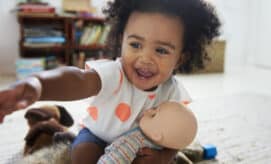During the first few years of life, children’s bodies grow stronger every day! As they develop, infants begin engaging their muscles and discovering new ways to move their bodies. These early movements are foundational to the development of gross motor skills, which utilize large muscles for important milestones such as rolling over, crawling, and walking.
In this article, we explore gross motor development in infancy and toddlerhood, including a few ways that caregivers can support the little ones in their care as they grow strong and healthy through movement.
Defining Gross Motor Skills
Gross motor skills involve the movements made with large muscles, “like those in your legs, arms and torso”, according to an article and illustrated diagram posted by the Cleveland Clinic. “Gross, in this case, means ‘large’ and motor means ‘movement’. Walking and waving your arms are examples of gross movements.”
Other gross motor skill movements include crawling, standing, jumping, and bending over. These skills support important functions related to movement, such as balance and coordination. Because movement is a part of everyday life, these skills are important for children to learn and practice as they grow. We want the little ones in our care to grow up to be strong and healthy, and supporting early gross motor skill development helps to create a strong foundation for them as they get older.
Developmental Milestones
Gross motor skill development begins in infancy, forming a foundation for further motor development throughout childhood. Below, you will find some of the key milestones in gross motor development that you might observe in infants and toddlers, according to the Center for Disease Control and Prevention (CDC).
Birth – 6 Months
In the first few months of life, children are already taking in the world around them. They are just beginning to get a sense of their ability to move and control their bodies, and they are starting to experiment with utilizing movement to explore their surroundings.
- Around 2 months, you might notice infants moving both arms and legs and holding up their head when placed on their tummies.
- By 4 months, you can often observe little ones using their arms to swing at toys, holding their head steady without support when being held, and pushing up onto elbows when placed on their stomachs.
- Around 6 months old, you might observe little ones rolling from tummy to back and leaning on their hands to support themselves while sitting.
9 Months – 1 Year






